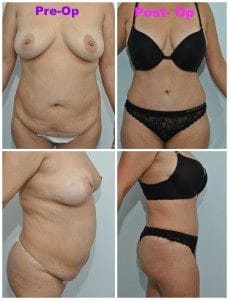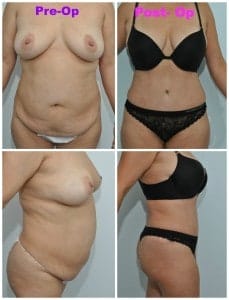The “tummy-tuck” is known in medical terms as abdominoplasty, a common surgery these days. This surgery was first introduced about 80 years ago, when surgeons performed this procedure in order to remove excess skin and fat (“apron”) hanging from the lower abdomen. In those times, the procedure was considered more “plastic” than “aesthetic” . It was performed in order to cure the infections that occurred in the folds of skin above the pubic area and improve the patient’s ability to move and bend at the waist to reach the lower part of their body. With great medical advances, the procedure has become more popular. More people are now considered good candidates for the surgery, and in time, almost any woman who goes through a pregnancy and gains some weight because of it can benefit from the procedure. This is the reason that this procedure is part of what is colloquially called a “mommy make-over.” Also, the surgery is fully indicated in patients with massive weight loss, in order to remove the excess skin that results from the weight loss. In the last decade, it was also observed that liposuction could be combined with an abdominoplasty, making the results better and even safer. A tummy-tuck combined with a conservative liposuction performed on the upper abdomen and flanks, plus tightening of the abdominal musculature (i.e., suturing the muscles in the midline to obtain a tighter abdomen) will deliver amazing results and will help enormously with one’s self-esteem.
The surgery is usually performed under general anesthesia, but on occasion, when necessary, can be performed with light sedation by an anesthetist combined with tumescent local anesthesia. The keys to the success of the procedure are (1) the location of the abdominoplasty scar and (2) the reconstruction of the navel (bellybutton). The scar needs to be as low as possible and extended carefully to the sides, taking into consideration the patient’s usual undergarments and swimwear. This is extremely important because the scars will be visible if the surgical incisions are made too far up or too far to the sides to be covered by these types of clothing. The “new” navel, which is actually the patient’s own navel brought out through a buttonhole created in the proper location on the abdomen, needs to be the right size and of course must be perfectly positioned in the midline. The proper location of the navel depends on the care taken by, and the keen eye of the operating surgeon. There are measurements that need to be done during the surgery, and also the surgeon needs to be sure, when suturing the muscles in the midline (as mentioned above), that the navel doesn’t displace to one or the other side, or up or down. At the point that the excess skin and fat is removed and the incisions start to be closed, the buttonhole that will be the new location of the navel needs to be precisely marked on the skin. A special instrument should be available and used to that end. The incision performed to create the navel needs to have a curvilinear shape and needs to be the proper size in order to avoid enlargement of the navel, which unfortunately is commonly seen.
Reducing the size of the navel is not easy and might require the creation of additional vertical incisions around the area. Moreover, if the resulting scars are not of the best quality, the stigmata will be visible forever on the abdomen. In summary, the proper low position of the abdominoplasty incision and its extension to each side, as well as the position and size of the navel, are of paramount importance during this surgery defining the outcome of the procedure. The quality of the muscle reconstruction, the location of the navel and the resulting scars are what differentiate an adequate surgeon from an excellent one.








